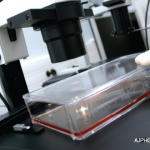The main message for rheumatologists: “TRIM 21 is not only an autoantigen in inflammatory myopathies, but its actions as a ubiquitin ligase are involved in the pathophysiology of these disease,” Dr. Barrera said, adding that further research on the function of Ro52/TRIM 21 will have “profound implications for understanding its role in idiopathic inflammatory myopathies.”
Anti-Synthetase Syndrome
In a third presentation on ongoing research on the disease mechanisms behind anti-synthetase syndrome, Baptiste Hervier, MD, INSERM & UPMC, Paris, France, presented findings of a study that looked at the effect of two known natural cytotoxicity receptor-3 (NKp30) ligands, B7-H6 and BAT3, on disease development. Previous work showed that NK cells and the NKp30 pathway are involved in patients with active anti-synthetase syndrome, suggesting their contribution to pathogenesis of this syndrome.
The study found that the BAT3 ligand correlates with disease activity and event-free survival, which suggests, according to Dr. Hervier, that BAT3 and its receptor NKp30 may be involved in the pathogenesis of anti-synthetase syndrome.
The importance of this finding? “This innate immune pathway could further stimulate the innate immune system, promoting autoimmunity,” he said. “When confirmed, such involvement could allow for the development of new therapeutic agents for anti-synthetase syndrome.”
Clinical Questions Addressed
Whether or not the concomitant use of a statin with colchicine to treat patients with gout is associated with a risk of developing myopathy was assessed in a study by Korean investigators. The study included 674 patients with gout, 486 of whom received colchicine alone and 188 who received colchicine with a statin.
Presenting the findings of the study, Oh Chan Kwon, MD, University of Ulsan College of Medicine, Asan Medical Center, Seoul, Korea, highlighted that the study found that statins can be added safely to colchcine for the treatment of gout. The study found no difference in the myopathy rate between patients who received colchicine alone or with the addition of a statin (1.4% vs 2.7%, P=0.330).
When looking at other factors that may increase the risk of developing myopathy, however, a multivariate analysis found that patients with chronic kidney disease and liver cirrhosis were associated with an increased risk. In addition, colchicine dose increment and CYP 3A4 inhibitor use were also independent risk factors for developing myopathy.
Based on these findings, Dr. Kwon emphasized that “colchicine dose increment and coadministration of CYP 3A4 inhibitors should be avoided if possible.”
‘Trim21 is not only an autoantigen in inflammatory myopathies, but its actions as a ubiquitin ligase are involved in the pathophysiology of these disease.’ —Dr. Barrera
Another clinical question addressed in a study presented by Christina Boros, MBBS, PhD, FRACP, senior lecturer, University of Adelaide Discipline of Paediatrics, was that of long-term patient-reported outcomes in adolescents and young adults diagnosed with idiopathic inflammatory myositis (IIM) in childhood.



